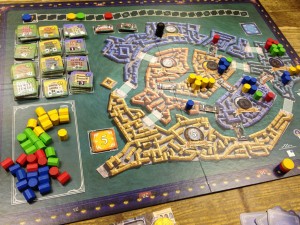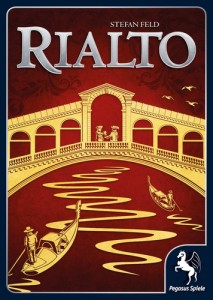Review: Rialto
Posted by James (admin) on May 14th, 2013
 Rialto is yet another of this year’s game by Stefan Feld (which is a good thing as I like most of his games).
Rialto is yet another of this year’s game by Stefan Feld (which is a good thing as I like most of his games).
Set in Venice, Rialto is played over 6 rounds – one for each of the Venetian islands on the board. Players are aiming to score the most victory points (VPs) which are primarily earned by having councilors on the islands at the end of the game. Players each have a marker on the Doge track and this splits all ties and determines some order of play.
Each island has 1 connection to each of its 4 neighbouring islands. During the game, these 12 connections each get filled with either a bridge or a gondola token. Each bridge and gondola token has two values on it (one on each end) – bridges have values between 3-6 VPs; whereas, both values on gondolas are always value 1. This is important because the final VPs gained by players with councilmen on each island are based on the total of each island’s 4 connections’ values.
At the start of each round, several (number of players + 1) rows of cards are laid out each consisting of 6 face-up and 2 face-down cards. In Doge track order, players select one row of cards, add any extra cards they may have (such as from the previous round), and discard down to 7 cards. The player may own some buildings which allow them to have more cards to select from, or keep more than 7 cards) but players must pay 1 gold for each building used.
Once all players have selected a row of cards, the rest of the round takes place over 6 phases and only one specific card type can be played during each phase. Going clockwise, players play any number of the phase’s cards (plus jokers). Playing more cards gives a greater benefit and the player that plays the most cards in each phase gets that phase’s bonus action. The list below shows the phases in order, the benefits and the bonus (where x represents the number of cards played):
- Doge cards: Move x spaces along Doge track (Bonus: +1 move)
- Gold cards: Gain x gold (Bonus: +1 gold)
- Building cards: Take building of value equal to x or less (Bonus: +1 building value)
- Bridge cards: Score x per card (Bonus: Place bridge between two islands)
- Gondola cards: Move x councilmen from your general supply to your personal supply (Bonus: Place gondola between two islands plus 1 councilman onto one of the islands it connects)
- Councilman cards: Move x councilmen from your personal supply onto current island (Bonus: Place +1 councilmen)
All players get the benefit of the cards they play, i.e. a player who plays 3 gold cards in the gold card phase will gain 3 gold (or will gain 4 gold if they played the most gold cards). Whilst cards are played in clockwise order, the effects are executed in Doge order and any ties are decided by the players’ position along the Doge track. In some cases the resolution order makes no difference (like when taking gold) but it can make a difference such as when moving on the Doge track (as the player on the top of another on the same space of the Doge track is ahead) as well as taking buildings (as they are in limited supply). The player that won the bonus action in one phase is the player that starts the next phase. Some buildings can be used to have 1 card count as 2 cards of another type, etc.
Buildings give players very useful extra abilities and are worth VPs at the end of the game. As mentioned above some can be used to affect the cards you draw and keep, some let you affect playing cards, and there are some others that do things like upgrading buildings, gaining VPs etc. The effects of the buildings may seem minor to start with but they’re very useful and can be even more effective when combined. The buildings you select will give you more tactics/choices. However, you must use cards to build them and must pay 1 gold to use each building (once per round). So, you need to make sure you gain gold to be able to keep using them.
At the end of the game, players with the most councilmen on an island score VPs equal to its value, the player with second most gets half of that, third most place gets half of that, and so on. Plus, there are some other VPs to be added too such as VPs for buildings.

Overall, I enjoyed Rialto. From reading the rules, I wasn’t sure if there was going to be much depth to it, but there’s a lot going on. You never have enough cards to everything you want (an aspect I always like) and this forces you to make difficult choices, especially as you’re not sure what other players will do so can not guarantee you will win the bonus actions.
The placement of the bridges ans gondolas is very clever as it means the VPs for each island take shape over the course of the game and makes each game different. However, it also means that winning the bonus actions to place the bridge and gondola pieces is very important and can really effect the game. You may add lots of councilmen to an island but you need to make sure bridges get placed to make it worth a decent amount of VPs too. Also, placing gondolas is important as you can ensure they don’t get allocated to the islands where you have councilmen, but you can also allocate them to where your opponents have their councilmen.
Players have lots to balance – use lots of cards of one type to get a single, big benefit and hopefully gain bonus action, or use lots of different cards to do multiple, different types of actions. Also, players need to move councilmen from the general supply into their own supply so they can then be placed on the islands. Buildings need coins to power them but gaining coins means doing fewer other things. So, everything you do is at the expense of doing something else.
There also seemed several tactical routes to take. In my first game, one player decided not to bother with the Doge track at all – resigning himself to losing all ties and being last to pick cards but at the benefit of not needing to collect or use and Doge cards at all (and he made it work too). Players can focus on buildings (also worth VPs), or placing bridges/gondolas to maximise their score and hinder others, or purely aim for placing councilmen.
There are some interesting ways to affect the game’s result too. For example, not only does winning the gondola round allow you to place a low-scoring gondola to connect islands that other players will score, but it is also the only way to add a councilman to an island that isn’t the current round’s island.
One minor negative is that resolving each phase can be a little bit fiddly. The order you play cards in is simply clockwise, but the order in which you resolve them is then in Doge track order (which is important for some phases). This is simple but the changing order can make it a bit fiddly – just enough to disrupt the flow – and players need to be strict in following this order.
Another negative is that I found some areas of the rules very unclear – primarily the description of the timing and order of resolving each phase. All the facts are stated in isolation, but that doesn’t clearly explain how the game flows – a bit like a list of ingredients doesn’t explain how to cook a meal. Just a little bit more description, or an example of play when resolving a phase of card play, would have solved this.
However, these negatives are minor items and Rialto is a solid Eurogame with more difficult and interesting choices than it may first appear. Plus, there is almost no downtime as players are involved in every phase. It’s actually quite a simple game but with lots of elements to balance (although it may be a bit too unusual for players who are new to boardgames).
James.
[Played with 4 and 5 players]

